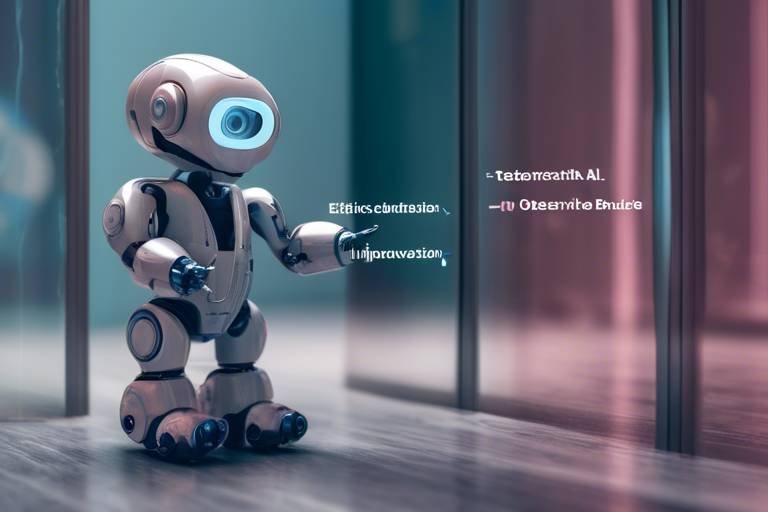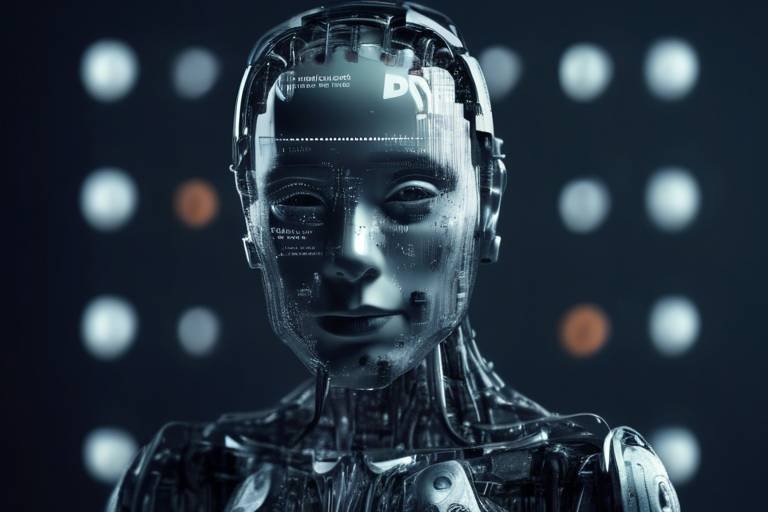AI and Ethics: Negotiating the Narrow Path
In today’s fast-paced digital world, the rapid advancement of artificial intelligence (AI) is nothing short of astounding. However, with great power comes great responsibility. As we navigate this narrow path between innovation and ethical considerations, it becomes increasingly clear that the intersection of AI and ethics is not just a theoretical debate; it’s a pressing reality that affects us all. So, why should we care about ethics in AI? Well, think of AI as a double-edged sword. On one side, it offers incredible potential to enhance our lives, streamline processes, and solve complex problems. On the other side, if left unchecked, it can lead to significant societal harm, perpetuating biases, invading privacy, and making decisions that impact our lives without human oversight.
The challenges of AI ethics are multifaceted and complex. Imagine walking a tightrope where one misstep could lead to disastrous consequences. As AI technologies continue to evolve, the ethical implications of their use become more pronounced. For instance, consider a self-driving car that needs to make split-second decisions in life-threatening situations. Who is responsible for the outcome? The developers? The manufacturers? Or the AI itself? These questions are not just academic; they have real-world implications that require thoughtful consideration and robust ethical frameworks.
Moreover, as AI systems become more integrated into our daily lives—from healthcare to finance to social media—ensuring that these technologies reflect our values and principles is crucial. We must ask ourselves: Are we building AI that is fair, accountable, and transparent? Are we prepared to address the ethical dilemmas that emerge as these technologies become more autonomous? The answers to these questions will shape the future of AI and its role in society.
In this article, we will delve into the importance of ethics in AI, explore key ethical principles that guide responsible AI development, and examine the ethical challenges that arise during AI deployment. We will also look ahead to the future of AI ethics, considering how we can proactively address emerging dilemmas. By the end of this journey, we hope to illuminate the path forward, helping to ensure that AI serves humanity in a manner that is not only innovative but also ethical.
Understanding why ethics is crucial in AI development helps ensure that technology aligns with societal values and norms, preventing harmful consequences and fostering trust among users and stakeholders.
This section outlines fundamental ethical principles, such as fairness, accountability, and transparency, which serve as guiding frameworks for responsible AI design and implementation.
Addressing bias in AI systems is essential to promote fairness. This subsection discusses strategies for identifying and mitigating bias in algorithms to ensure equitable outcomes.
Ensuring diverse data representation is crucial in preventing biased AI outcomes. This part examines the importance of inclusive datasets in developing fair AI systems.
Algorithmic accountability involves tracing decision-making processes in AI systems. This segment highlights the need for clear accountability mechanisms to address potential harms caused by AI technologies.
Transparency is vital for building trust in AI. This section discusses the importance of explainability and how clear communication of AI operations can enhance user confidence.
AI deployment poses various ethical challenges, including privacy concerns and the potential for misuse. This section explores these challenges and offers insights into responsible deployment practices.
Protecting user privacy is a significant ethical concern in AI. This subsection delves into the importance of data protection measures to safeguard personal information in AI applications.
The use of AI in critical decision-making raises ethical questions about human oversight. This part emphasizes the need for human intervention to ensure ethical considerations are upheld in automated processes.
As AI technology evolves, so do ethical considerations. This section looks ahead to emerging trends and potential frameworks for addressing future ethical dilemmas in AI development and use.
- What is AI ethics? AI ethics refers to the moral principles that govern the development and use of artificial intelligence technologies.
- Why is fairness important in AI? Fairness ensures that AI systems do not perpetuate bias and provide equitable outcomes for all users.
- How can transparency be achieved in AI? Transparency can be achieved through clear communication of how AI systems operate and make decisions.
- What are the main ethical challenges in AI deployment? Key challenges include privacy concerns, bias, accountability, and the need for human oversight.

The Importance of Ethics in AI
In today's rapidly evolving technological landscape, the significance of ethics in artificial intelligence (AI) cannot be overstated. As we integrate AI into various facets of our lives—from healthcare to finance, and even entertainment—it's crucial that these technologies align with our societal values and norms. Why is this alignment so important? Because without a solid ethical framework, we risk creating systems that could lead to harmful consequences, perpetuate inequalities, or even infringe on individual rights.
Imagine a world where AI systems make decisions that affect our lives without any ethical considerations. It’s a chilling thought, isn't it? This is precisely why ethics serves as the backbone of responsible AI development. By prioritizing ethical considerations, we not only foster trust among users and stakeholders but also ensure that AI technologies contribute positively to society. In essence, the ethical landscape of AI is like a compass guiding us through uncharted waters, helping us navigate the potential pitfalls that could arise from unchecked technological advancement.
Moreover, the importance of ethics in AI extends beyond just avoiding negative outcomes. It also encourages innovation that is inclusive and equitable. When ethical principles are embedded in the design and deployment of AI systems, we can create solutions that are beneficial for all, rather than a select few. This inclusivity is vital in building a future where technology uplifts and empowers everyone, rather than exacerbating existing disparities.
To illustrate this point, consider the following key aspects of why ethics is crucial in AI:
- Trust Building: Ethical AI fosters trust among users, encouraging them to embrace new technologies.
- Accountability: Establishing ethical guidelines ensures that developers and organizations are held accountable for their AI systems.
- Long-term Viability: Ethical considerations help ensure the sustainability of AI technologies, promoting their acceptance and integration into society.
In conclusion, the importance of ethics in AI cannot be ignored. It serves as a critical framework for guiding the development and deployment of AI technologies, ensuring they align with our values and contribute positively to society. As we continue to innovate and explore the potential of AI, let's remember that ethics isn't just an afterthought—it's an integral part of the journey toward a better, more equitable future.

Key Ethical Principles in AI
When it comes to artificial intelligence, the stakes are incredibly high. The ethical principles guiding the development and deployment of AI are not just buzzwords; they are essential frameworks that ensure technology serves humanity rather than undermines it. At the heart of these principles are three key concepts: fairness, accountability, and transparency. Each of these principles plays a crucial role in shaping AI systems that are not only effective but also responsible.
Fairness is about ensuring that AI systems treat all individuals equitably. Imagine a world where algorithms dictate who gets a loan or a job based solely on biased data. That's a nightmare scenario! To prevent such outcomes, developers must actively work to identify and mitigate biases present in their algorithms. This involves rigorous testing and validation processes to ensure that the AI systems are not inadvertently perpetuating existing inequalities.
Addressing bias in AI systems is essential for promoting fairness. A fair AI system can be likened to a well-balanced scale, where every individual is given equal weight, regardless of their background. To achieve this balance, developers should implement strategies such as:
- Regular Audits: Conducting audits of AI systems to identify any biases in decision-making.
- Diverse Data Sets: Utilizing diverse and representative data sets to train AI algorithms.
- Community Involvement: Engaging with affected communities to understand their needs and concerns.
By actively addressing these biases, AI can be designed to produce equitable outcomes, thus fostering greater trust among users.
Ensuring diverse data representation is crucial in preventing biased AI outcomes. Think of data as the food that feeds the AI; if the diet is lacking in variety, the AI's understanding of the world becomes skewed. Inclusive datasets are vital for developing fair AI systems. For instance, if an AI system is trained primarily on data from one demographic, it may fail to accurately understand or serve others. Therefore, the collection and use of diverse datasets should be a top priority for developers.
Algorithmic accountability refers to the responsibility of developers to trace the decision-making processes in AI systems. Without accountability, we risk creating a “black box” scenario where users cannot understand how decisions are made. This lack of transparency can lead to mistrust and skepticism. To combat this, clear accountability mechanisms must be established. This includes documenting the development process, providing explanations for AI decisions, and allowing for external audits. By doing so, we can ensure that AI technologies do not cause harm and that there are avenues for redress when they do.
Transparency is vital for building trust in AI. Just like you wouldn’t buy a car without knowing how it works, users need to understand AI systems to feel comfortable using them. This involves not only making the algorithms understandable but also communicating how data is used and how decisions are made. When AI systems are transparent, users can feel more confident in their interactions, knowing that they are not just pawns in an unseen game. Thus, fostering a culture of transparency is essential for responsible AI development.
In summary, the key ethical principles of fairness, accountability, and transparency are foundational to the responsible development and deployment of AI technologies. By adhering to these principles, we can navigate the complex landscape of AI ethics and ensure that technology serves the greater good.
- What is the most important ethical principle in AI?
While all principles are crucial, fairness often takes precedence as it directly impacts individuals' lives and opportunities. - How can bias in AI be identified?
Bias can be identified through regular audits, testing algorithms with diverse datasets, and soliciting feedback from affected communities. - Why is transparency important in AI?
Transparency builds trust and allows users to understand how AI systems operate, which is essential for ethical use.

Fairness and Bias Mitigation
In the rapidly evolving world of artificial intelligence, the concept of fairness is more critical than ever. As we integrate AI into various aspects of our lives, from hiring processes to law enforcement, we must confront the uncomfortable reality that these systems can perpetuate existing biases. Imagine a world where a machine, designed to assist in making decisions, inadvertently favors one group over another simply because of the data it was trained on. This is not just a hypothetical scenario; it’s a growing concern that demands our attention.
To navigate this narrow path of fairness, we need to actively identify and mitigate biases embedded within AI algorithms. The first step in this journey is understanding the sources of bias. Bias can creep in through various channels, such as the data used to train these systems, the design of the algorithms themselves, or the societal norms that influence how these technologies are implemented. Therefore, it’s essential to adopt a multi-faceted approach to tackle this issue.
One effective strategy for promoting fairness is to ensure that the data fed into AI systems is diverse and representative. This means actively seeking out and including data from various demographics, backgrounds, and experiences. For example, consider a facial recognition system that has been trained predominantly on images of lighter-skinned individuals. Such a system is likely to perform poorly when identifying people of darker skin tones, leading to unfair outcomes. By using a more inclusive dataset, we can work towards minimizing these biases.
Moreover, we can utilize techniques such as algorithmic auditing and testing to assess the fairness of AI systems. Regularly evaluating algorithms for bias can help identify issues before they escalate into significant problems. This process can be enhanced by creating a
that outlines key metrics for assessing fairness:| Metric | Description | Importance |
|---|---|---|
| Disparate Impact | Measures the impact of AI decisions across different groups. | Helps identify potential biases. |
| Equal Opportunity | Assesses if all groups have equal chances of favorable outcomes. | Ensures fairness in decision-making. |
| Calibration | Checks if predicted probabilities correspond to actual outcomes. | Enhances trust in AI predictions. |
In addition to data diversity and algorithmic auditing, collaboration across sectors is vital. Engaging stakeholders, including ethicists, community representatives, and technologists, can lead to the development of a more holistic understanding of fairness in AI. By fostering open dialogues and sharing insights, we can create a shared vision for ethical AI that resonates with societal values.
Ultimately, achieving fairness in AI is not a one-time task but an ongoing commitment. As technology evolves, so too must our strategies for bias mitigation. By continuously refining our approaches and remaining vigilant against potential biases, we can pave the way for AI systems that not only perform efficiently but also uphold the principles of fairness and justice. Together, we can ensure that the future of AI is inclusive, equitable, and beneficial for all.
- What is bias in AI? Bias in AI refers to systematic favoritism or prejudice in decision-making processes, often resulting from unrepresentative training data.
- How can we identify bias in AI systems? Bias can be identified through algorithmic audits, testing for disparate impacts, and analyzing performance metrics across diverse demographic groups.
- Why is data diversity important? Data diversity is crucial because it helps to ensure that AI systems are trained on a wide range of inputs, promoting fairness and reducing the risk of biased outcomes.

Data Diversity and Representation
In the world of artificial intelligence, data diversity and representation are not just buzzwords; they are the bedrock upon which fair and equitable AI systems are built. Imagine trying to solve a puzzle, but you only have pieces from a few different boxes. The final picture will be skewed, incomplete, and potentially misleading. Similarly, if AI systems are trained on datasets that lack diversity, the outcomes can be biased, perpetuating stereotypes and inequalities.
To illustrate, consider a facial recognition system that predominantly uses images of individuals from a specific demographic. If the training data is not representative of the broader population, the system may struggle to accurately recognize faces from underrepresented groups. This can lead to significant real-world consequences, such as misidentification or exclusion from services. Thus, ensuring that datasets are inclusive and varied is essential for developing AI that serves everyone fairly.
Moreover, the importance of data diversity extends beyond just the technical aspects; it also touches on ethical and social implications. When we talk about representation in data, we are essentially discussing who gets to be seen and heard in the digital landscape. This is crucial because AI systems often reflect the values and biases of their creators. If those creators come from homogenous backgrounds, the AI may inadvertently reinforce existing societal biases. Therefore, embracing diversity in data collection involves actively seeking out voices and perspectives that have historically been marginalized.
One effective strategy for ensuring data diversity is to implement inclusive data practices throughout the data lifecycle. This includes:
- Conducting comprehensive audits of existing datasets to identify gaps in representation.
- Collaborating with diverse communities to gather data that accurately reflects their experiences and needs.
- Utilizing synthetic data generation techniques to augment datasets where real-world data is scarce.
Ultimately, the goal is to create AI systems that do not just function well but do so in a way that is fair and just. By prioritizing data diversity and representation, we can pave the way for AI technologies that empower all users, rather than marginalizing some. As we continue to navigate the complexities of AI, it becomes increasingly clear that the success of these technologies hinges on our commitment to inclusivity.
- Why is data diversity important in AI?
Data diversity ensures that AI systems are fair and equitable, preventing biases that can arise from non-representative datasets. - How can we improve representation in AI datasets?
By conducting audits, collaborating with diverse communities, and utilizing synthetic data, we can enhance representation in AI training data. - What are the consequences of biased AI systems?
Biased AI systems can lead to misidentification, discrimination, and perpetuation of stereotypes, affecting individuals and communities negatively.

Algorithmic Accountability
When we talk about , we're diving into a crucial aspect of artificial intelligence that often gets overlooked. The decisions made by AI systems can have profound impacts on individuals and society at large. Imagine a world where a simple algorithm could determine your eligibility for a loan or even influence your job prospects. Sounds a bit scary, right? That's why it's essential to have clear accountability mechanisms in place.
At its core, algorithmic accountability is about understanding and tracing the paths that lead to specific decisions made by AI systems. It’s not just about the output; it’s about the entire process that gets us there. For instance, if an AI system denies a loan application, the question arises: why was that decision made? Who is responsible for it? Without clear answers, we risk eroding trust in these technologies. That's why it's imperative to establish frameworks that ensure we can audit and explain AI decisions.
One effective way to enhance algorithmic accountability is through the implementation of explainability techniques. These techniques allow developers and users to understand how and why algorithms make specific decisions. For example, consider a table that outlines different explainability methods:
| Explainability Method | Description |
|---|---|
| LIME (Local Interpretable Model-agnostic Explanations) | Provides local approximations of the decision boundary of complex models. |
| SHAP (SHapley Additive exPlanations) | Assigns each feature an importance value for a particular prediction. |
| Decision Trees | Simple models that provide clear decision paths and rules. |
These methods not only help in understanding the decisions made by AI but also foster a culture of responsibility among developers. When developers know that their algorithms must be explainable, they are more likely to consider ethical implications during the design phase. We can think of it like building a bridge: if the engineers don’t account for the weight it needs to support, the structure could collapse. Similarly, if AI developers don’t consider the implications of their algorithms, they could lead to harmful outcomes.
Moreover, we need to establish clear lines of responsibility. This means determining who is accountable when things go wrong. Is it the developers, the companies, or the users? Having a transparent accountability structure can help mitigate risks associated with AI deployment. In a world where AI is increasingly making decisions on our behalf, it’s vital that we have mechanisms in place to hold parties accountable. This not only protects individuals but also enhances the overall integrity of AI technologies.
In conclusion, algorithmic accountability is not just a technical requirement; it's a moral imperative. As we continue to integrate AI into our daily lives, we must prioritize accountability to ensure that these systems serve us fairly and justly. After all, we are the ones who will ultimately live with the consequences of these algorithms. So, let’s make sure we’re not just programming machines but also building a future that reflects our shared values.
- What is algorithmic accountability?
Algorithmic accountability refers to the responsibility of developers and organizations to ensure that AI systems operate transparently and that their decision-making processes can be understood and traced.
- Why is algorithmic accountability important?
It is crucial because it helps build trust in AI systems, ensures ethical decision-making, and provides mechanisms to address potential harms caused by AI technologies.
- How can we achieve algorithmic accountability?
We can achieve it by implementing explainability techniques, establishing clear lines of responsibility, and fostering a culture of ethical considerations during the development of AI systems.

Transparency in AI Systems
In the rapidly evolving landscape of artificial intelligence, transparency has emerged as a cornerstone of ethical development and deployment. Imagine you're driving a car, but the dashboard is completely blank; you wouldn't feel safe, right? The same principle applies to AI systems. Users need to understand how these technologies operate to build trust and confidence. Transparency in AI not only enhances user experience but also promotes accountability among developers and organizations.
When we talk about transparency, we often refer to two key aspects: explainability and communication. Explainability involves making AI decision-making processes clear and understandable. If an AI system makes a recommendation, users should be able to grasp the reasoning behind it. This is especially crucial in high-stakes situations, such as healthcare or criminal justice, where decisions can have profound impacts on individuals' lives. Clear communication about how data is used and how algorithms function can demystify AI, making it less intimidating and more approachable for the average user.
Moreover, the absence of transparency can lead to a myriad of issues, including misuse and mistrust. For example, if an AI system is used in hiring processes without clear criteria, candidates might feel that decisions are arbitrary or biased. This lack of clarity can result in public backlash and erode trust in AI technologies. To address these concerns, organizations must adopt best practices that prioritize transparency, such as:
- Providing detailed documentation on AI algorithms and their decision-making processes.
- Implementing user-friendly interfaces that allow users to query AI systems about their operations.
- Engaging with stakeholders to gather feedback and improve transparency measures.
Additionally, the concept of algorithmic transparency is gaining traction. This involves not only explaining how algorithms work but also ensuring that the data used to train these algorithms is accessible and understandable. By promoting data transparency, we can combat biases that often creep into AI systems, leading to fairer outcomes. For instance, if an AI model is trained on biased data, the results will likely reflect those biases. Therefore, making datasets publicly available for scrutiny can help identify and mitigate these issues before they manifest in real-world applications.
In conclusion, transparency in AI systems is not just a nice-to-have; it's a necessity. By fostering an environment of openness, we can ensure that AI technologies are not only effective but also ethical and trustworthy. As we continue to integrate AI into various facets of our lives, prioritizing transparency will pave the way for a future where technology serves humanity responsibly and equitably.
- What is transparency in AI? Transparency in AI refers to the clarity and openness regarding how AI systems operate, including their decision-making processes and the data they use.
- Why is transparency important in AI? Transparency is crucial for building trust, ensuring accountability, and preventing misuse of AI technologies.
- How can organizations promote transparency in AI? Organizations can promote transparency by providing clear documentation, engaging stakeholders, and making datasets accessible for public scrutiny.

Ethical Challenges in AI Deployment
Deploying artificial intelligence (AI) is like walking a tightrope; one misstep can lead to significant ethical dilemmas that affect individuals and society as a whole. As we integrate AI into various sectors—be it healthcare, finance, or law enforcement—we face a myriad of ethical challenges that demand our immediate attention. Understanding these challenges is essential for creating responsible AI systems that enhance human life rather than complicate it.
One of the most pressing ethical concerns is privacy and data protection. With AI systems relying heavily on vast amounts of data, often including sensitive personal information, the risk of compromising user privacy is alarmingly high. Imagine a world where your every online interaction is monitored and analyzed—this is the reality we are inching closer to. To mitigate these risks, organizations must implement robust data protection measures, ensuring that user consent is obtained and that data is anonymized whenever possible. It's not just about compliance with regulations like GDPR; it's about fostering a culture of trust between AI developers and users.
Another ethical challenge arises from the use of AI in decision-making processes. As AI systems begin to take on roles traditionally held by humans—such as making hiring decisions or determining loan approvals—the question of accountability looms large. How can we ensure that these automated systems don't perpetuate existing biases or create new forms of discrimination? The need for human oversight becomes paramount. We must ask ourselves: should we allow machines to make decisions that significantly impact lives without human intervention? Striking a balance between efficiency and ethical responsibility is crucial as we navigate this uncharted territory.
Moreover, the potential for misuse of AI technologies poses significant ethical challenges. From facial recognition technology being used for surveillance to deepfake algorithms that can manipulate reality, the risks are extensive. It raises the question: who is responsible when AI is used for nefarious purposes? Organizations need to establish clear guidelines and accountability measures to prevent the misuse of AI technologies. This can include implementing ethical review boards that assess the implications of AI deployment and ensuring that developers adhere to ethical standards throughout the design and implementation phases.
To summarize, the ethical challenges in AI deployment are multifaceted and complex. Addressing these challenges requires a collaborative effort among developers, policymakers, and society at large. By prioritizing privacy, ensuring human oversight in decision-making, and preventing misuse, we can pave the way for a future where AI serves as a force for good rather than a source of ethical dilemmas.
- What are the main ethical challenges in AI deployment? The primary challenges include privacy and data protection, the need for human oversight in decision-making, and the potential for misuse of AI technologies.
- How can we protect user privacy in AI applications? Organizations can protect user privacy by implementing robust data protection measures, obtaining user consent, and anonymizing sensitive data.
- Why is human oversight necessary in AI decision-making? Human oversight is crucial to ensure that automated decisions do not perpetuate biases or lead to unfair outcomes.
- What can be done to prevent the misuse of AI technologies? Establishing ethical review boards and clear guidelines for AI deployment can help mitigate the risks of misuse.

Privacy and Data Protection
In our rapidly advancing digital age, the intersection of artificial intelligence and privacy has become a hotbed of ethical debate. As AI systems increasingly permeate our daily lives—from personal assistants to critical healthcare applications—protecting user privacy has emerged as a paramount concern. But what exactly does it mean to safeguard privacy in the context of AI? Well, it involves not only the protection of personal data but also ensuring that individuals maintain control over their information.
At the heart of this issue lies the concept of data protection. Organizations utilizing AI must implement robust measures to secure personal information against unauthorized access, breaches, and misuse. A single data leak can lead to devastating consequences, including identity theft and loss of trust among users. Therefore, the ethical implications of data handling practices cannot be overstated. Companies must not only comply with legal frameworks like the General Data Protection Regulation (GDPR) but also adopt best practices that prioritize user privacy.
One effective strategy for enhancing privacy in AI applications is through the use of anonymization techniques. By removing personally identifiable information from datasets, organizations can analyze trends and patterns without compromising individual privacy. However, it's crucial to recognize that anonymization is not foolproof. As AI technologies evolve, so do the methods used by malicious actors to re-identify anonymized data. This is why continuous vigilance and adaptation of privacy measures are essential.
Moreover, users should be empowered to understand and control how their data is used. Transparent communication about data collection practices fosters trust and allows individuals to make informed choices. Organizations can achieve this by providing clear privacy policies and easy-to-understand consent forms. As part of this effort, it’s beneficial to establish a feedback loop where users can voice their concerns and suggestions regarding data usage.
To illustrate the importance of privacy and data protection in AI, consider the following table, which outlines the key aspects and practices that organizations should adopt:
| Aspect | Best Practices |
|---|---|
| Data Minimization | Collect only the data necessary for the intended purpose. |
| Anonymization | Implement techniques to remove identifiable information from datasets. |
| User Control | Allow users to access, modify, and delete their personal data. |
| Transparency | Clearly communicate data usage policies and obtain informed consent. |
| Regular Audits | Conduct periodic assessments of data protection measures and compliance. |
In summary, the ethical landscape of AI is heavily influenced by privacy and data protection considerations. As we continue to harness the power of AI, it's imperative that we prioritize the safeguarding of personal information. By adopting best practices and fostering an environment of transparency, organizations can not only comply with legal obligations but also build lasting trust with their users. After all, in a world where data is currency, protecting that currency is not just smart—it's ethical.
- What is the importance of data protection in AI? Data protection is crucial in AI to prevent unauthorized access to personal information and to maintain user trust.
- How can organizations ensure privacy in AI systems? Organizations can ensure privacy by implementing data minimization, anonymization techniques, and transparent data usage policies.
- What are the consequences of failing to protect user data? Failing to protect user data can lead to identity theft, loss of trust, and legal repercussions for organizations.

AI in Decision-Making
The integration of artificial intelligence in decision-making processes has revolutionized various industries, from healthcare to finance. However, this advancement brings with it a plethora of ethical questions that cannot be ignored. Imagine a world where machines make critical decisions about your health or finances—sounds convenient, right? But what happens when these decisions go wrong? The stakes are incredibly high, and that's why we need to ensure that human oversight remains a fundamental aspect of AI-driven decision-making.
One of the key ethical concerns is the potential for automation bias. This occurs when humans place undue trust in AI systems, often leading to poor decision outcomes. For instance, if a medical AI suggests a treatment plan, a doctor might overlook their own expertise in favor of the machine's recommendation. This blind trust can lead to catastrophic results, especially in scenarios involving life-and-death decisions. To combat this, it's essential to foster a culture where human judgment complements AI capabilities rather than defers to them.
Moreover, the complexity of AI algorithms can make it challenging for users to understand how decisions are reached. This lack of transparency can erode trust and raise ethical concerns. If a loan application is denied by an AI system, the applicant deserves to know why. Was it due to their credit score, or was there an underlying bias in the algorithm? Without clear explanations, individuals may feel powerless and frustrated, leading to a wider distrust of AI technologies.
To address these issues, we need to implement robust frameworks that ensure human oversight in AI decision-making processes. This includes:
- Regular audits of AI systems to ensure they function as intended.
- Establishing clear accountability protocols for decisions made by AI.
- Training stakeholders to understand AI operations better, enabling them to intervene when necessary.
In addition, it's vital to incorporate ethical guidelines into the development of AI technologies. By doing so, we can create systems that not only enhance decision-making but also prioritize the well-being of individuals. Think of it this way: just as a pilot relies on instruments to navigate, humans should be equipped with the tools and knowledge to navigate AI-assisted decisions safely.
As we move forward, the challenge will be to strike the right balance between leveraging AI's capabilities and maintaining essential human oversight. The future of AI in decision-making depends on our ability to navigate this narrow path, ensuring that technology serves humanity without compromising ethical standards.
- What is automation bias? - Automation bias is the tendency to favor suggestions from automated systems, potentially leading to poor decision-making.
- How can we ensure AI transparency? - Transparency can be achieved through clear communication of how AI systems make decisions and regular audits of their processes.
- Is human oversight necessary in AI decision-making? - Yes, human oversight is crucial to ensure ethical considerations are upheld and to mitigate risks associated with automated decisions.

Future Directions for AI Ethics
The landscape of artificial intelligence is constantly evolving, and with it, the ethical considerations that accompany its development and deployment. As we look to the future, it's essential to recognize that the challenges we face today will likely multiply as technology advances. This means that the conversation around AI ethics must not only continue but also adapt to new realities. Just like navigating a river that changes course, we must be agile and responsive to the currents of innovation and societal expectations.
One of the most promising directions for AI ethics is the development of comprehensive frameworks that integrate ethical considerations into the entire lifecycle of AI systems. This involves not just the initial design and deployment but also ongoing monitoring and evaluation. Imagine a ship that not only sets sail but also has a crew that constantly checks the weather, adjusting the sails as needed. Similarly, AI systems should be continuously assessed for ethical compliance and societal impact.
Moreover, the collaboration between technologists, ethicists, and policymakers is becoming increasingly vital. As AI technologies are deployed in various sectors—healthcare, finance, education, and beyond—the need for interdisciplinary dialogue is paramount. This collaboration can help ensure that ethical considerations are embedded in the design and implementation processes. Think of it as a team of chefs collaborating in a kitchen, each bringing their unique expertise to create a delicious meal that satisfies everyone's palate.
Another critical aspect of the future of AI ethics is the emphasis on public engagement. The general public must be involved in discussions about AI's ethical implications, as they are the ones who will ultimately be affected by these technologies. We need to create platforms for open dialogue where individuals can voice their concerns and opinions. This could be likened to a town hall meeting where community members come together to discuss important issues, ensuring that diverse perspectives are heard and considered.
Furthermore, the integration of ethical AI principles into educational curricula will be essential. By teaching future generations about the ethical implications of AI, we can cultivate a more responsible tech-savvy workforce. Imagine teaching kids not just how to code but also how to think critically about the impact of their creations. This proactive approach can help prevent ethical oversights before they occur.
Lastly, as AI continues to permeate various aspects of life, the importance of regulatory oversight cannot be understated. Governments and international bodies must establish clear guidelines and regulations that promote ethical AI development while still fostering innovation. This balancing act is akin to walking a tightrope; it requires careful attention to maintain equilibrium between progress and ethical responsibility.
In summary, the future of AI ethics is a multifaceted journey that requires ongoing dialogue, interdisciplinary collaboration, public engagement, education, and regulatory frameworks. By embracing these directions, we can navigate the complexities of AI technology responsibly, ensuring that it serves humanity's best interests.
- What is AI ethics? AI ethics refers to the moral principles and guidelines that govern the development and use of artificial intelligence technologies.
- Why is ethics important in AI? Ethics is crucial in AI to ensure that technologies align with societal values, prevent harm, and foster trust among users.
- What are some key ethical principles in AI? Key principles include fairness, accountability, transparency, and privacy.
- How can bias be mitigated in AI systems? Bias can be mitigated through diverse data representation, continuous monitoring, and algorithmic accountability.
- What role does public engagement play in AI ethics? Public engagement ensures that diverse perspectives are considered in discussions about AI's ethical implications, fostering a more inclusive dialogue.
Frequently Asked Questions
- What is the significance of ethics in AI development?
Ethics in AI development is crucial because it ensures that technology aligns with societal values and norms. This alignment helps prevent harmful consequences and fosters trust among users and stakeholders. When developers prioritize ethics, they create AI systems that are not only innovative but also responsible and fair.
- How can we address bias in AI systems?
Addressing bias in AI systems involves identifying and mitigating biases present in algorithms. Strategies include using diverse datasets, implementing fairness audits, and continuously monitoring AI systems for biased outcomes. By ensuring that AI is trained on inclusive data, we can promote fairness and equity in the results produced by these systems.
- What are the key ethical principles guiding AI?
The key ethical principles guiding AI include fairness, accountability, and transparency. Fairness ensures equitable outcomes, accountability involves tracing decision-making processes, and transparency builds trust by making AI operations understandable to users. These principles serve as vital frameworks for responsible AI design and implementation.
- Why is transparency important in AI?
Transparency is critical for building trust in AI systems. When users understand how AI makes decisions, they feel more confident in its applications. Clear communication about the operations of AI enhances user trust and encourages responsible use of technology, ensuring that people are informed about potential risks and benefits.
- What are the ethical challenges associated with AI deployment?
AI deployment presents several ethical challenges, including privacy concerns and the potential for misuse. Protecting user privacy is paramount, as AI applications often handle sensitive personal information. Additionally, the risk of AI being used for harmful purposes necessitates responsible deployment practices to safeguard against unethical use.
- How does AI impact decision-making processes?
The use of AI in decision-making raises ethical questions about human oversight. It's essential to ensure that human intervention is maintained in critical processes to uphold ethical considerations. By combining AI efficiency with human judgment, we can create a balanced approach that prioritizes ethical standards while leveraging the strengths of both AI and human input.
- What are the future directions for AI ethics?
As AI technology evolves, ethical considerations will also change. Future directions for AI ethics may include developing new frameworks that address emerging trends, such as increased automation and enhanced data privacy regulations. Continuous dialogue among stakeholders will be vital to navigate these evolving challenges and ensure responsible AI development and use.



















